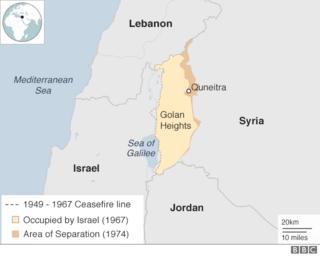Home » Middle East »
Golan Heights profile
The Golan Heights, a rocky plateau in south-western Syria, has a political and strategic significance which belies its size.
Israel seized the Golan Heights from Syria in the closing stages of the 1967 Six-Day War. Most of the Syrian Arab inhabitants fled the area during the conflict.
An armistice line was established and the region came under Israeli military control. Almost immediately Israel began to settle the Golan.
Syria tried to retake the Golan Heights during the 1973 Middle East war. Despite inflicting heavy losses on Israeli forces, the surprise assault was thwarted. Both countries signed an armistice in 1974 and a UN observer force has been in place on the ceasefire line since 1974.
Israel unilaterally annexed the Golan Heights in 1981. The move was not recognised internationally, although the US Trump Administration did so unilaterally in March 2019.
There are more than 30 Jewish settlements on the heights, with an estimated 20,000 settlers. There are some 20,000 Syrians in the area, most of them members of the Druze sect.
Strategic importance
Southern Syria and the capital Damascus, about 60 km (40 miles) north, are clearly visible from the top of the Heights while Syrian artillery regularly shelled the whole of northern Israel from 1948 to 1967 when Syria controlled the Heights.
The heights give Israel an excellent vantage point for monitoring Syrian movements. The topography provides a natural buffer against any military thrust from Syria.
The area is also a key source of water for an arid region. Rainwater from the Golan’s catchment feeds into the Jordan River. The area provides a third of Israel’s water supply.
The land is fertile, and the volcanic soil is used to cultivate vineyards and orchards and raise cattle. The Golan is also home to Israel’s only ski resort.
Stumbling blocks
Syria wants to secure the return of the Golan Heights as part of any peace deal. In late 2003, Syrian President Bashar al-Assad said he was ready to revive peace talks with Israel.
In Israel, the principle of returning the territory in return for peace is already established. During US-brokered peace talks in 1999-2000, then Israeli prime minister Ehud Barak had offered to return most of the Golan to Syria.
But the main sticking point during the 1999 talks is also likely to bedevil any future discussions. Syria wants a full Israeli withdrawal to the pre-1967 border. This would give Damascus control of the eastern shore of the Sea of Galilee – Israel’s main source of fresh water.
Israel wishes to retain control of Galilee and says the border is located a few hundred metres to the east of the shore.
A deal with Syria would also involve the dismantling of Jewish settlements in the territory.
Public opinion in Israel has generally not favoured withdrawal, saying the Heights are too strategically important to be returned.
On-off talks
Indirect talks between Israel and Syria resumed in 2008, through Turkish government intermediaries, but were suspended following the resignation of Israeli Prime Minister Ehud Olmert over a corruption inquiry.
The Israeli government under Binyamin Netanyahu elected in February 2009 indicated that it was determined to take a tougher line over the Golan, and in June 2009 Syria said there was no partner for talks on the Israeli side.
Syrian civil war
The US administration of President Barack Obama declared the restarting of talks between Israel and Syria to be one of its main foreign policy goals, but the advent of civil war in Syria in 2011 put paid to any progress.
Syrian fighting reached the Golan ceasefire lines in 2013, but the resurgent Syrian government felt confident enough to reopen its Golan border crossing to UN observers in October 2018.
Source: Read Full Article



